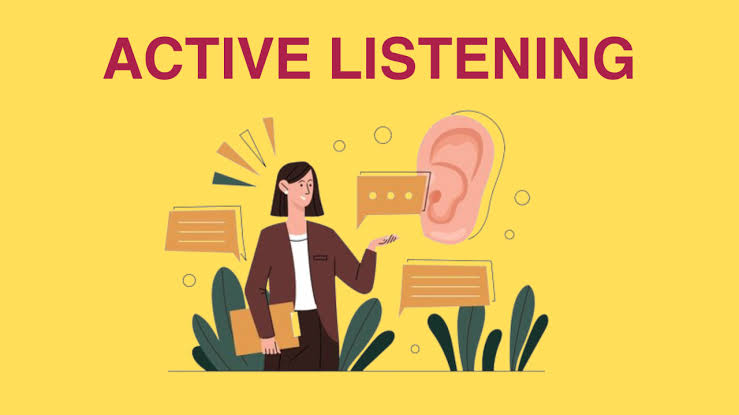Active listening means fully paying attention to someone when they talk. It involves understanding, thinking about what they say, and responding carefully. This skill helps people build trust, show care, and connect better with others at work and in life. Unlike just hearing, active listening needs you to focus on the speaker’s words, tone, and body language.
This skill has gained increasing importance in today’s fast-paced, digitally connected world. As communication becomes more fragmented through screens and devices, mastering active listening can significantly enhance clarity and reduce misunderstandings.
Core Elements of Active Listening
Active listening is made up of several distinct yet interconnected elements that contribute to effective communication. Each element plays a crucial role in ensuring that the listener fully understands and respects the speaker.
- Attention and Presence
True active listening starts with giving the speaker your undivided attention. This means putting away distractions such as phones, turning to face the speaker, and maintaining eye contact. Being mentally present shows that you value what the other person has to say. - Non-Verbal Cues
Body language plays a huge part in active listening. Nodding occasionally, maintaining an open posture, and using appropriate facial expressions can all indicate genuine engagement. Silence also has power—it allows the speaker to express their full thoughts without interruption. - Paraphrasing and Reflecting
Reflecting back what you’ve heard in your own words shows that you’ve been attentive and understand the message. Phrases like “So what you’re saying is…” or “Let me make sure I understand…” help clarify and confirm understanding. - Asking Thoughtful Questions
Good listeners ask questions—not to interrogate, but to deepen understanding. These questions should relate to what was said, showing interest and curiosity. Open-ended questions tend to work best as they invite further discussion. - Avoiding Judgement or Premature Advice
Often, people just want to be heard. Offering solutions too quickly or judging what is being said can shut down meaningful communication. Active listening requires withholding assumptions and keeping an open mind.
Benefits of Active Listening in Different Settings
The benefits of active listening ripple across multiple areas of life. Whether in professional environments, relationships, or education, mastering this art can produce powerful outcomes.
In the Workplace
In professional settings, active listening improves teamwork, collaboration, and leadership. Managers who practice it foster a culture of respect and openness, encouraging employees to share ideas or concerns. It reduces workplace conflict, enhances problem-solving, and leads to more efficient decision-making.
Employees who listen actively are better able to understand tasks, follow instructions, and engage in meaningful dialogue with colleagues or clients. It also plays a central role in customer service, where truly understanding a client’s concern can lead to more satisfying solutions.
In Relationships
In personal relationships, active listening builds emotional intimacy and trust. Whether between partners, friends, or family members, the act of truly listening makes the other person feel seen and valued. It reduces the likelihood of arguments stemming from miscommunication and strengthens the emotional bond.
In Education
For students and educators alike, active listening is critical to comprehension and retention. Teachers who listen to students better understand their needs, while students who listen actively absorb lessons more deeply. It also encourages collaborative learning and respectful discussions.
Common Barriers to Active Listening
Even with the best intentions, several barriers can hinder active listening. Recognizing and addressing these obstacles is key to improving communication.
- Distractions – External noise, phones, or even internal thoughts can draw focus away.
- Prejudice or Bias – Judging a speaker based on past experiences or appearance affects how their message is received.
- Impatience – A desire to speak or move the conversation along may result in interrupting or tuning out.
- Emotional Triggers – Certain topics may cause an emotional reaction that clouds objective listening.
Overcoming these challenges takes practice and self-awareness. Mindfulness techniques and communication training can help listeners become more present and responsive.
Tips for Developing Active Listening Skills
Improving active listening isn’t a one-time task—it’s a continuous process of practice and reflection. Here are some actionable steps to get started:
- Practice Being Fully Present
Eliminate distractions before engaging in conversation. Focus entirely on the speaker’s words, expressions, and tone. - Use Verbal Affirmations
Words like “I see,” “Go on,” or “That makes sense” show the speaker you’re engaged without interrupting their flow. - Mirror Emotions
Acknowledge the speaker’s feelings through empathetic responses. For example: “That sounds really difficult” or “You must be excited about that.” - Avoid Rehearsing Responses
Many people think about what to say next while someone is still talking. Try to pause and think after they finish instead. - Record and Reflect
After important conversations, mentally replay how you listened. Ask yourself what went well and what could improve. - Join Workshops or Training
Many communication or leadership programs now include modules on active listening. These structured environments can accelerate skill-building.
The Role of Empathy in Active Listening
At the heart of active listening lies empathy. It’s not just about understanding words but connecting to the speaker’s emotions and intentions. Empathy involves stepping into another person’s perspective, feeling their experience without necessarily agreeing or fixing the situation.
Empathetic listening creates a safe environment where people feel heard and validated. It strengthens trust and encourages open communication, especially in emotionally sensitive conversations.
Conclusion
Active listening is a powerful yet often underused skill in modern communication. It requires intention, attention, and emotional intelligence—but the rewards are vast. From deepening relationships to excelling in leadership and collaboration, mastering the art of active listening can transform how we connect with others.
By making a conscious effort to truly listen, we not only honor the voices around us but also grow into more effective communicators, partners, and leaders. In a world where everyone wants to be heard, being a great listener is one of the most impactful things you can become.



